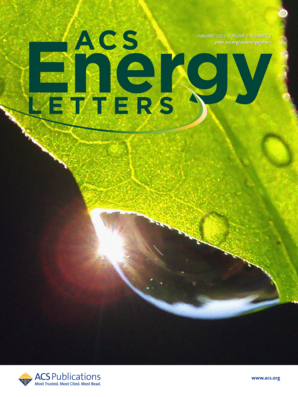Mechanochemical Thioglycolate Modification of Microscale Zero-Valent Iron for Superior Heavy Metal Removal
IF 19.3
1区 材料科学
Q1 CHEMISTRY, PHYSICAL
引用次数: 0
Abstract
Microscale zero-valent iron (mZVI) is widely used for water pollutant control and environmental remediation, yet its reactivity is still constrained by the inert oxide shell. Herein, we demonstrate that mechanochemical thioglycolate (TG) modification can dramatically enhance heavy metal (NiII, CrVI, CdII, PbII, HgII, and SbIII) removal rates of mZVI by times of 16.7 to 88.0. Compared with conventional impregnation (wet chemical process), this dry mechanochemical process could construct more robust covalent bonding between TG and the inert oxide shell of mZVI through its electron-withdrawing carboxylate group to accelerate the electron release from the iron core, and more effectively strengthen the surface heavy metal adsorption through metal(d)-sulfur(p) orbital hybridization between its thiol group and heavy metal ions. Impressively, this mechanochemically TG-modified mZVI exhibited an unprecedented NiII removal capacity of 580.4 mg Ni g−1 Fe, 17.1 and 9.5 times those of mZVI and wet chemically TG-modified mZVI, respectively. Its application potential was further validated by more than 10 days of stable groundwater NiII removal in a column flow reactor. This study offers a promising strategy to enhance the reactivity of mZVI, and also emphasizes the importance of the modification strategy in optimizing its performance for environmental applications.机械化学法硫代乙酸盐改性微尺度零价铁以提高重金属去除率
微尺度零价铁(mZVI)被广泛用于水污染物控制和环境修复,但其反应活性仍受到惰性氧化物外壳的限制。在此,我们证明了机械化学硫代乙酸盐(TG)改性可显著提高 mZVI 对重金属(NiII、CrVI、CdII、PbII、HgII 和 SbIII)的去除率,提高幅度为 16.7 到 88.0 倍。与传统的浸渍法(湿化学法)相比,这种干式机械化学法可以通过 mZVI 的汲电子羧酸基团在 TG 与惰性氧化物外壳之间构建更牢固的共价键,从而加速铁芯的电子释放,并通过其硫醇基团与重金属离子之间的金属(d)-硫(p)轨道杂化,更有效地加强表面重金属吸附。令人印象深刻的是,这种机械化学 TG 改性的 mZVI 表现出了前所未有的 NiII 去除能力,达到 580.4 mg Ni g-1 Fe,分别是 mZVI 和湿化学 TG 改性 mZVI 的 17.1 倍和 9.5 倍。在柱流反应器中超过 10 天的稳定地下水 NiII 去除进一步验证了其应用潜力。这项研究为提高 mZVI 的反应活性提供了一种很有前景的策略,同时也强调了改性策略在优化其环境应用性能方面的重要性。
本文章由计算机程序翻译,如有差异,请以英文原文为准。
求助全文
约1分钟内获得全文
求助全文
来源期刊

ACS Energy Letters
Energy-Renewable Energy, Sustainability and the Environment
CiteScore
31.20
自引率
5.00%
发文量
469
审稿时长
1 months
期刊介绍:
ACS Energy Letters is a monthly journal that publishes papers reporting new scientific advances in energy research. The journal focuses on topics that are of interest to scientists working in the fundamental and applied sciences. Rapid publication is a central criterion for acceptance, and the journal is known for its quick publication times, with an average of 4-6 weeks from submission to web publication in As Soon As Publishable format.
ACS Energy Letters is ranked as the number one journal in the Web of Science Electrochemistry category. It also ranks within the top 10 journals for Physical Chemistry, Energy & Fuels, and Nanoscience & Nanotechnology.
The journal offers several types of articles, including Letters, Energy Express, Perspectives, Reviews, Editorials, Viewpoints and Energy Focus. Additionally, authors have the option to submit videos that summarize or support the information presented in a Perspective or Review article, which can be highlighted on the journal's website. ACS Energy Letters is abstracted and indexed in Chemical Abstracts Service/SciFinder, EBSCO-summon, PubMed, Web of Science, Scopus and Portico.
 求助内容:
求助内容: 应助结果提醒方式:
应助结果提醒方式:


